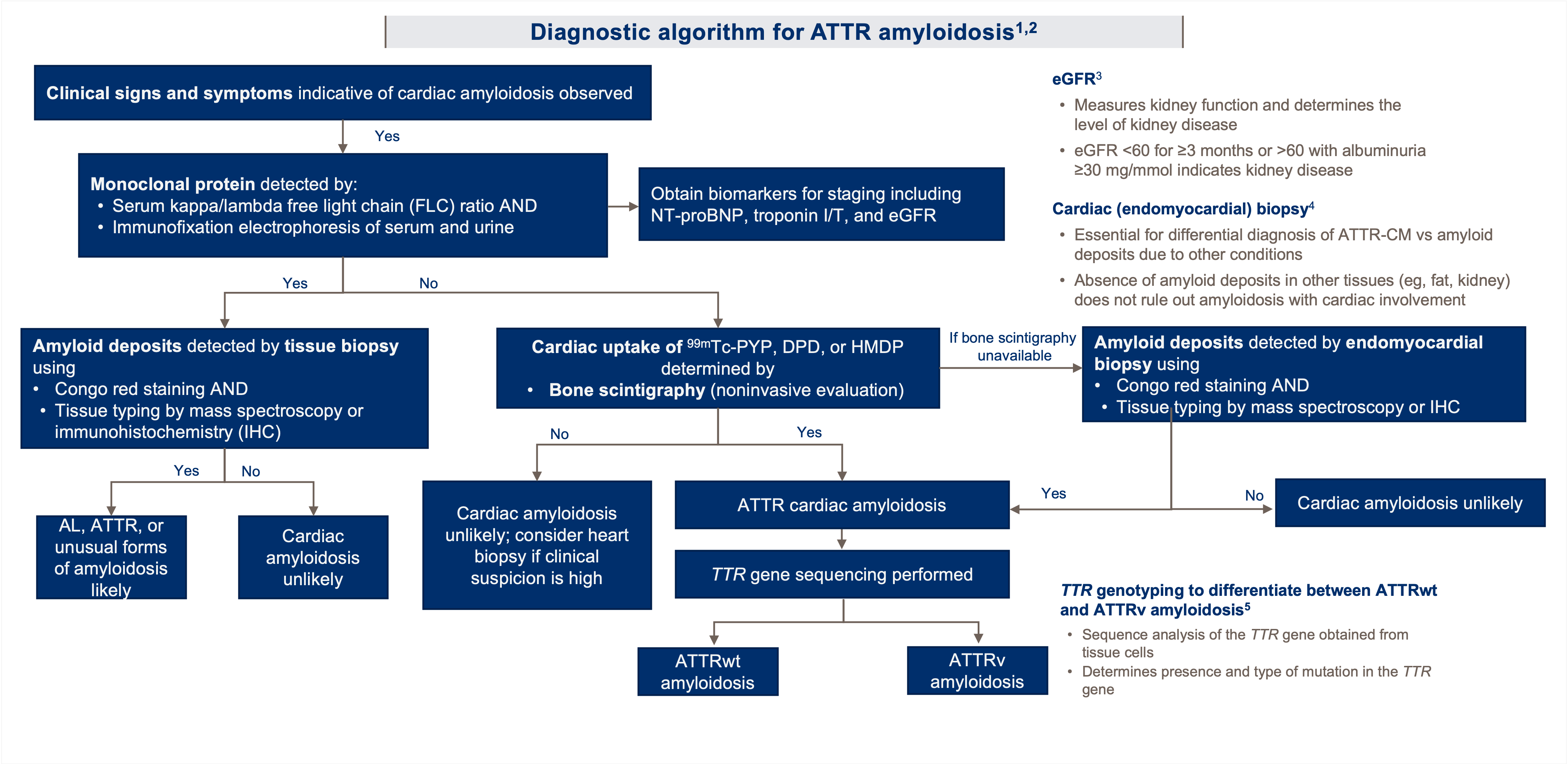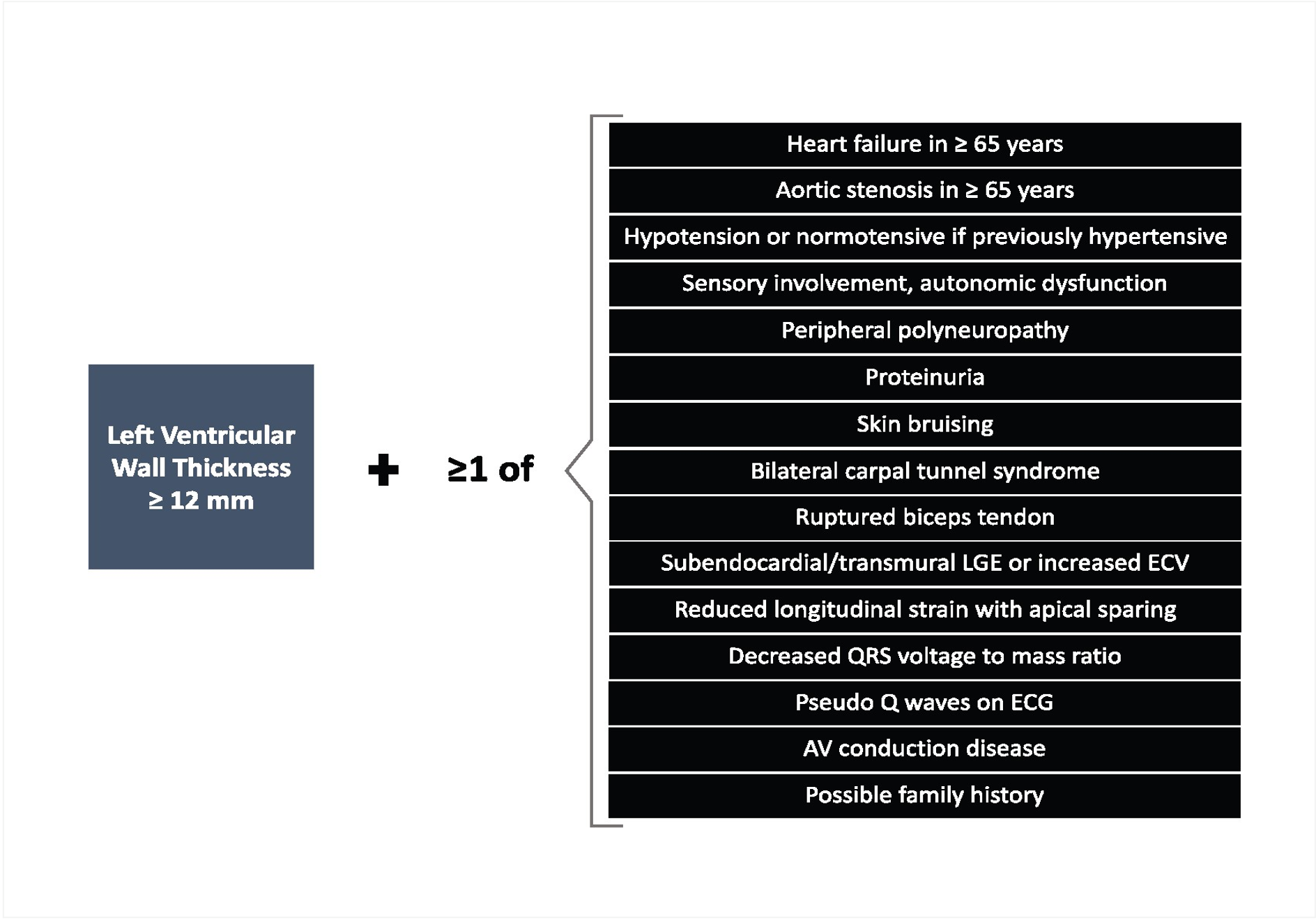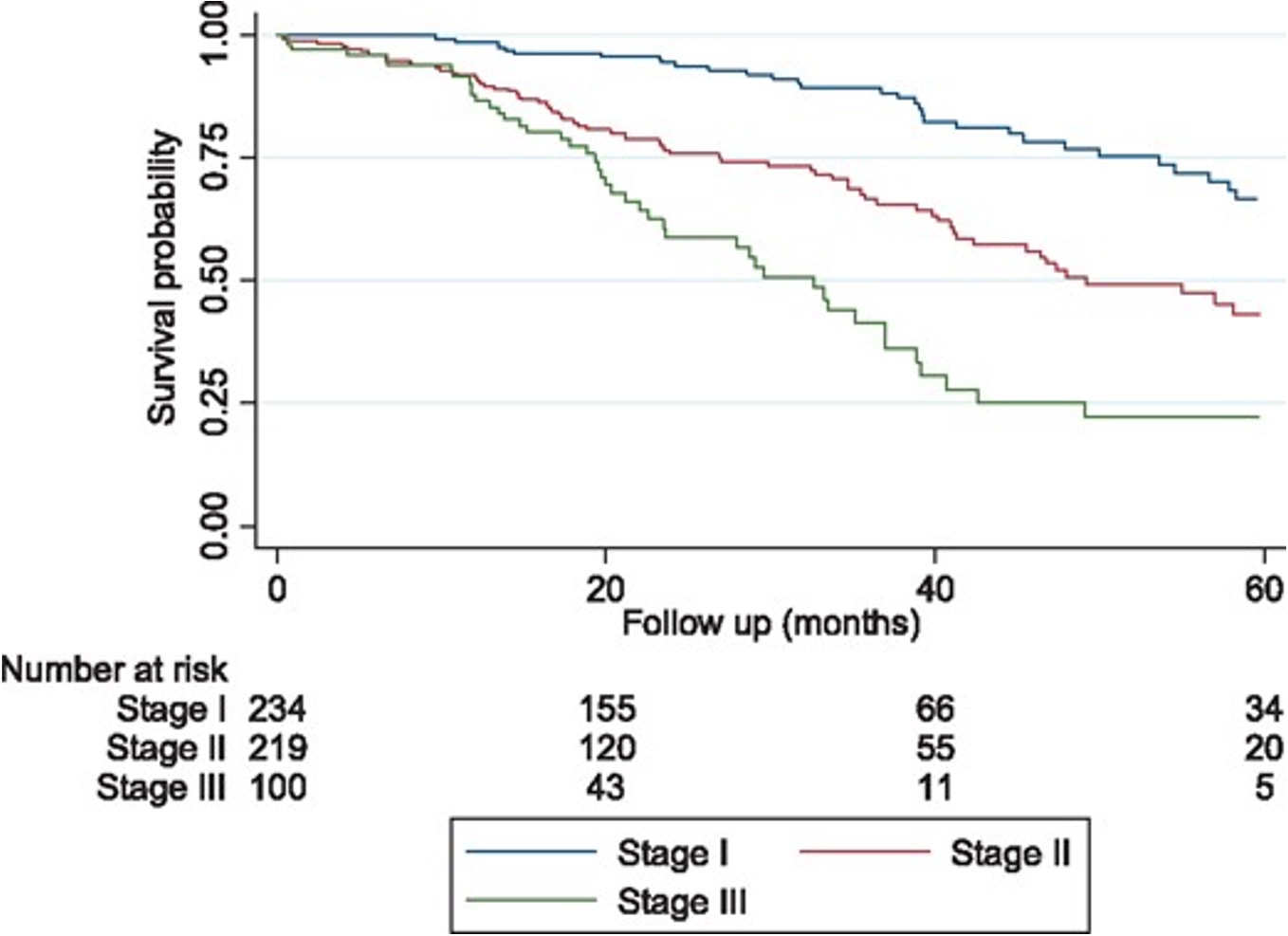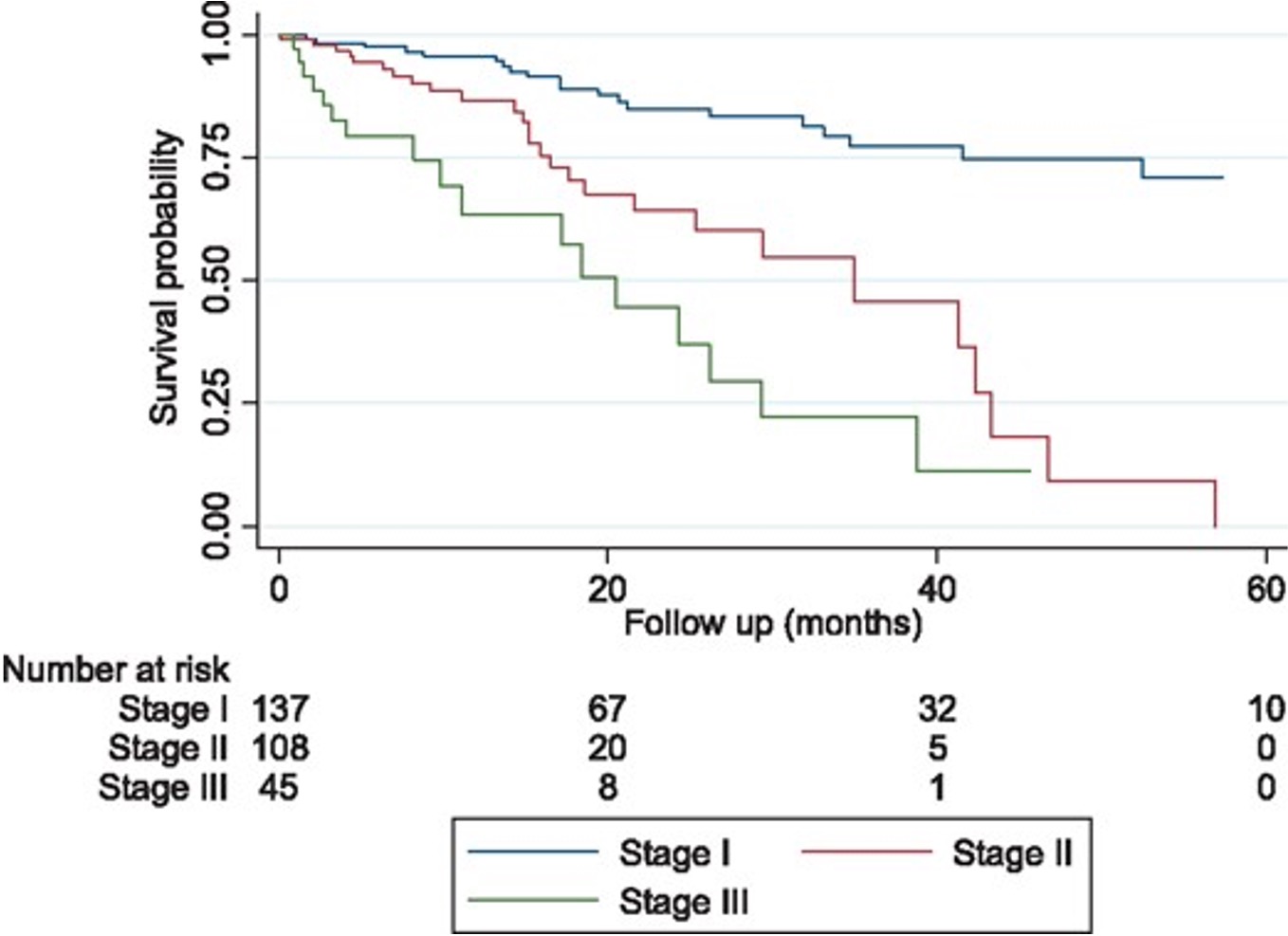- ALXN: 32_2021 Amyloidosis March KOL Perspectives_Cristina Quarta_FINAL. Citing:Amyloidosis Foundation. AL Amyloidosis. http://amyloidosis.org/facts/al/#diagnosis. Accessed September 17, 2020.
Diagnosis & Staging
Diagnosis is a Multistage Process
Amyloidosis Clinical Presentation & Typical Lab Findings
Cardiac & Extracardiac Red Flags for CA
Cardiac and Extracardiac Amyloidosis Red Flags

- Garcia-Pavia P, et al. Diagnosis and Treatment of Cardiac Amyloidosis: A Position Statement of the ESC Working Group on Myocardial and Pericardial Diseases. Eur Heart J. 2021;42(16):1554-1568. DOI: https://doi.org/10.1093/eurheartj/ehab072.
Imaging Techniques for Suspicion of ATTR-CM
- Firkle M, et al. Cor et Vasa. 2013;55:e60-e75.
- Kitaoka H, et al. Circ J. 2020;84:1610-1671.
- Healio. Introduction to ECG. https://www.healio.com/cardiology/learn-the-heart/ecg-review/ecg-interpretation-tutorial/introduction-to-the-ecg. Accessed August 23, 2021.
- Quarta CC, et al. Circulation. 2012;126:e178-e182.
- Ruberg FL, Grogan M, Hanna M, Kelly JW, Maurer MS. Transthyretin Amyloid Cardiomyopathy: JACC State-of-the-Art Review. J Am Coll Cardiol. 2019;73(22):2872-91.
Potential Gender Differences in Biopsy Predictiveness
- Based on results of previous studies showing that male patients were more prone to cardiac ATTR deposition than female patients, it was speculated that females may develop cardiomyopathy at later stages of the disease, thus allowing for more amyloid accumulation in non-cardiac tissues
- It has not been determined whether this rule applies to patients with ATTRwt, however, 80% of female patients in the cohort in whom an abdominal fat pad biopsy was performed were positive for amyloid (8 out of 10 patients)*
- Abdominal fat biopsy is clearly less invasive than EMB, and it is suggested that abdominal fat biopsy should be performed particularly in elderly female patients with suspected ATTRwt
Notes: * Although the number of patients was relatively small, female ATTRwt patients had a higher sensitivity for TTR detection in abdominal fat tissue, smaller LV cavity, milder LVH, and a higher frequency of preserved LVEF than male ATTRwt patients; there have been few studies in which sex differences in ATTRwt have been investigated, and information on japanese female patients with ATTRwt remains insufficient
- Ochi Y, Kubo T, Baba Y, et al. Wild-Type Transthyretin Amyloidosis in Female Patients - Consideration of Sex Differences. Circ Rep. 2021;3(8):465-471. Published 2021 Jun 29. doi:10.1253/circrep.CR-21-0067.
Diagnostic Algorithm: Japanese Circulation Society (JCS) 2020 Guidelines

- Macroglossia, enlargement of the tongue
- Magnetic resonance imaging (MRI), a medical imaging technique that uses strong magnetic fields and radio waves to produce detailed images of the inside of the body
- Myeloma protein (M protein), an abnormal antibody or fragment that is excessively produced by the monoclonal proliferation of B lymphocytes and plasma cells. M protein typically occurs in disorders known as monoclonal gammopathies, paraproteinemias, or plasma cell dyscrasias such as multiple myeloma
- ALXN: Acoramidis for the Treatment of ATTR-CM: Training Deck. November 22, 2021. 34_Acoradmidis Training Deck_22Nov21 FINAL. Citing: Kitaoka H, et al. Circ J. 2020;84:1610-1671.
Diagnostic Algorithm for ATTR Amyloidosis

- ⁹⁹ᵐ technetium (Tc)-3,3-diphosphono-1,2-propanodicarboxylic acid (DPD), ⁹⁹ᵐTc-hydroxymethylene diphosphonate (HMDP), ⁹⁹ᵐTc-pyrophosphate (PYP), tracers used in bone scintigraphy
- Electrophoresis, a laboratory technique to separate and analyze macromolecules such as DNA, RNA, and proteins based on their size and electrical charge
- Endomyocardial, relating to the innermost layer of the heart that lines the chambers (endocardium) and the middle muscular layer of the heart (myocardium)
- Free light chain (FLC), light chain not bound to a heavy chain to form immunoglobulin (antibody)
- Immunofixation, a test for detecting the presence and type of certain proteins (monoclonal antibodies, immunoglobulins)
- Immunohistochemistry (IHC), a laboratory technique that allows imaging of different components in tissues by using fluorescently-tagged or appropriately-labeled antibodies that bind specifically to target antigens (markers)
- Kappa (κ) subtype, a subtype of immunoglobulin light chain; twice as common as λ in humans
- Lambda (λ) subtype, a subtype of immunoglobulin light chain; half as common as κ in humans
- Mass spectroscopy, an analytical technique that identifies molecules by fragmenting them into charged species (ions) and measuring their mass-to-charge ratios
- Scintigraphy, a diagnostic technique in which a scintillation counter or similar detector is used with a radioactive tracer to obtain an image of an organ or a record of its functioning
- Troponin T (TnT), part of a protein complex integral to contraction of heart and skeletal muscle; elevation indicates injury to the heart
- Ruberg FL, et al. J Am Coll Cardiol. 2019;73:2872-2891.
- Kittleson MM, et al. Circulation. 2020;142:e7-e22. Erratum in: Circulation. 2021;144:e11.
- National Kidney Foundation. Estimated glomerular filtration rate (eGFR). Accessed August 16, 2021. https://www.kidney.org/atoz/content/gfr.
- Veinot JP. Can J Cardiol. 2009;25(2):e55-e56.
- Maurer MS, et al. Circ Heart Fail. 2019;12:e006075.
Staging ATTR Amyloidosis
Mayo Clinic Staging System (Grogan, et al.)
- The first published staging system for ATTRwt is based on serum levels of NT-proBNP and cardiac troponin T
- Thresholds of troponin T (0.05 ng/ml) and NT-proBNP (3000 pg/ml) were used
- The respective four-year overall survival estimates were 57%, 42%, and 18% for stage I (both values below cutoff), stage II (one above), and stage III (both above), respectively [1,2]
Notes: Notes: BNP = brain natriuretic peptide; NAC = National Amyloidosis Centre (UK); NT-proBNP = N-terminal pro b-type natriuretic peptide
Notes: * (Top left) Death rates based on troponin T cutpoint of 0.05 ng/ml. Numbers below the plot represent number of subjects at risk at each time point. The age- and sex-adjusted hazard ratio (HR) was 2.34 (95% confidence interval [CI]: 1.46 to 3.76) with a c-statistic of 0.72 (95% CI: 0.66 to 0.78). Cross-validated c-statistic was 0.71 (95% CI: 0.65 to 0.78). (Top right) Death rates based on N-terminal pro–B-type natriuretic peptide (NT-proBNP) cutpoint of 3,000 pg/ml. Numbers below the plot represent number of subjects at risk at each time point. The age- and sex-adjusted HR was 2.22 (95% CI: 1.36 to 3.60) with a c-statistic of 0.72 (95% CI: 0.65 to 0.78). Cross validated c-statistic was 0.71 (95% CI: 0.65 to 0.78). (Bottom) Death rates based on staging system, overlaid with expected survival based on age and sex. Numbers below the plot represent numbers of subjects at risk at each time point. The age- and sex-adjusted HR was 1.42 (95% CI: 0.79 to 2.57) for 1 above and 3.60 (95% CI: 2.02 to 6.42) for 2 above, with a c-statistic of 0.74 (95% CI: 0.68 to 0.80). Cross-validated c-statistic was 0.73 (95% CI: 0.67 to 0.79)2
Notes: ** These include newer high-sensitivity troponin T (hs-TnT) assays, which not only differ in sensitivity but also give different numerical results to older assays, and troponin I assays3
NAC Staging System (Gillmore, et al.)
- The second staging system, validated in both ATTRwt and ATTRv, is based on serum levels of NT-proBNP and eGFR
- Stage I is defined as NT-proBNP ≤3000 ng/L and eGFR ≥45 mL/min, Stage III is defined as NT-proBNP >3000 ng/L and eGFR <45 mL/min, and the remainder were Stage II
- Median survival among Stage I patients was 69.2 months, Stage II patients 46.7 months, and Stage III patients 24.1 months [1,3]
- Fontana, Marianna. Mar. 23, 2021. Amyloid cardiomyopathy: Treatment and prognosis. UptoDate. https://www.uptodate.com/contents/amyloid-cardiomyopathy-treatment-and-prognosis#H89526001.
- Grogan M, Scott CG, Kyle RA, Zeldenrust SR, Gertz MA, Lin G, Klarich KW, Miller WL, Maleszewski JJ, Dispenzieri A. Natural History of Wild-Type Transthyretin Cardiac Amyloidosis and Risk Stratification Using a Novel Staging System. J Am Coll Cardiol. 2016 Sep 6;68(10):1014-20. doi: 10.1016/j.jacc.2016.06.033. Erratum in: J Am Coll Cardiol. 2017 Jun 13;69(23):2882. PMID: 27585505.
- Gillmore JD, Damy T, Fontana M, Hutchinson M, Lachmann HJ, Martinez-Naharro A, Quarta CC, Rezk T, Whelan CJ, Gonzalez-Lopez E, Lane T, Gilbertson JA, Rowczenio D, Petrie A, Hawkins PN. A new staging system for cardiac transthyretin amyloidosis. Eur Heart J. 2018 Aug 7;39(30):2799-2806. doi: 10.1093/eurheartj/ehx589. PMID: 29048471.












